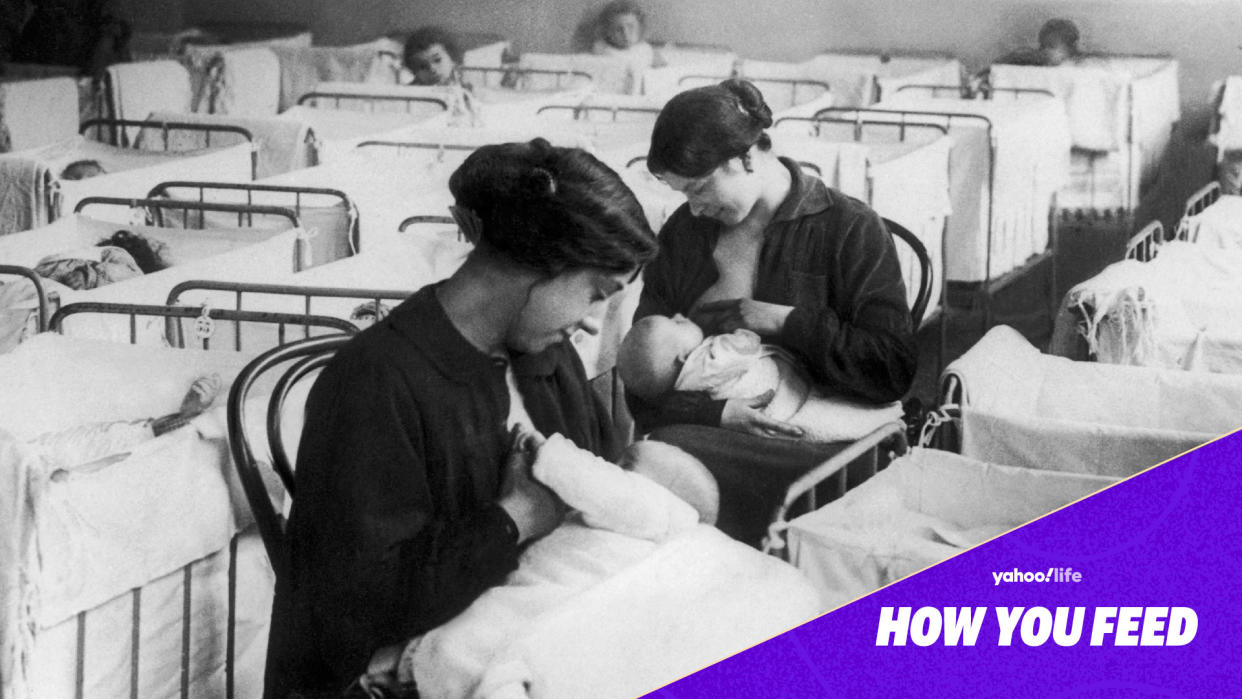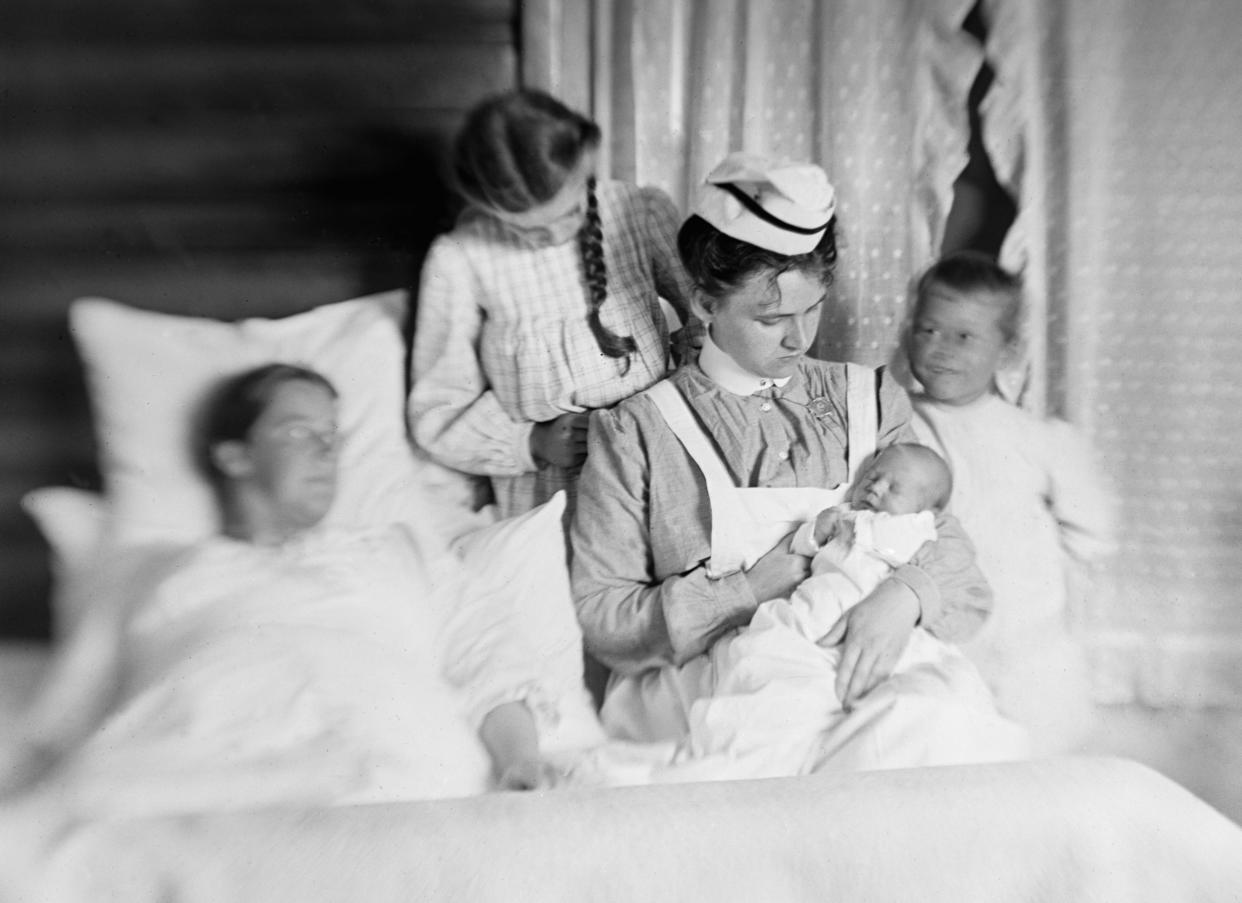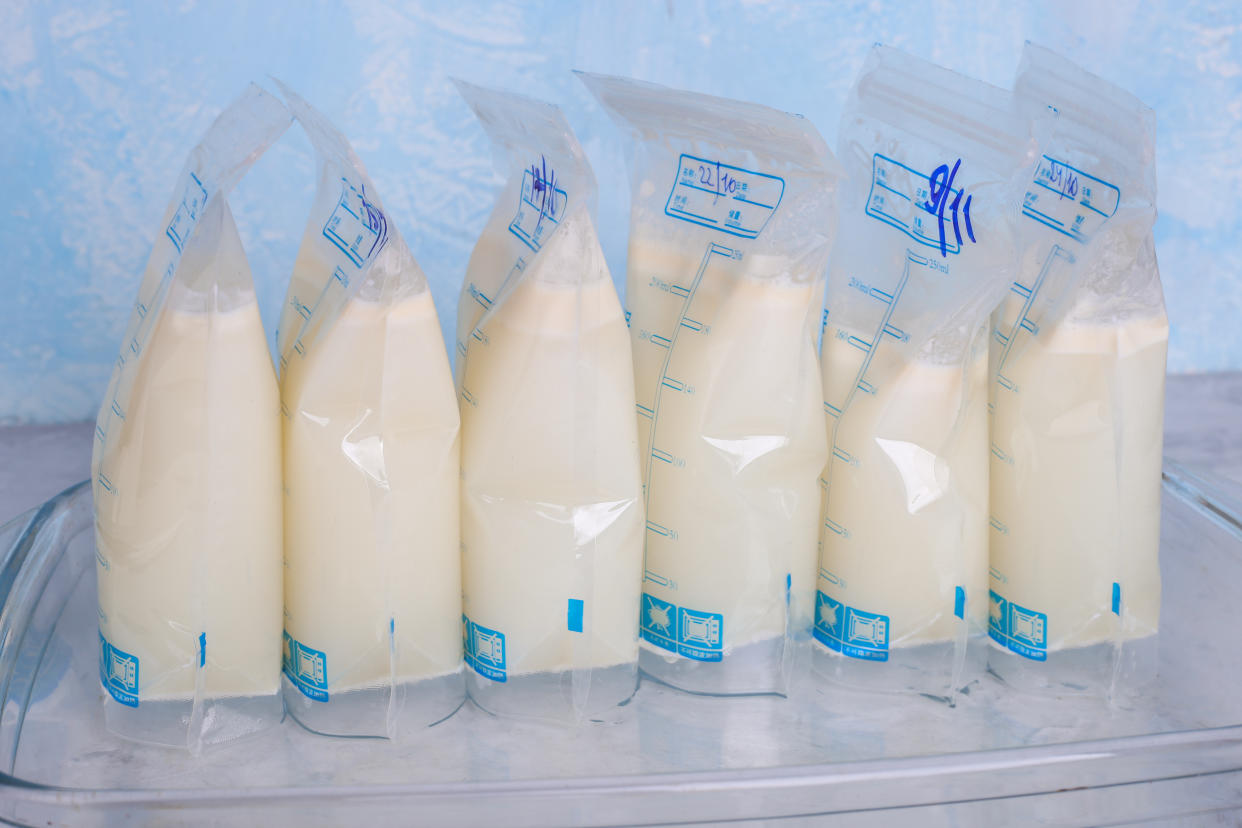The controversial history of wet nursing and what the 'informal,' 'underground' practice looks like today

Breast, bottle, whatever: How You Feed is a shame-free series on how babies eat.
With many families scrambling for solutions to the U.S. formula shortage, stories of local women volunteering to serve as wet nurses have popped up around the internet, which raises the question: Is wet-nursing even a thing anymore?
Turns out, it is. While the the profession of wet nursing is less common today thanks to modern alternatives like formula and breast milk banks, the informal practice of wet nursing, some say, is still alive and well. It just isn’t talked about.
The controversial history of wet nursing in the U.S.
In the U.S. there have been two main avenues of wet nursing: One, the profession of wet nursing, has a long history of abuse and is bound by monetary exchange — or in the case of the antebellum South, the exploitation of enslaved Black women who were forced to give their breast milk to white babies. The other form of wet nursing is more informal and takes place between family, friends or other equals without uneven power dynamics; it’s often unpaid and may also be referred to as “cross-feeding” or “cross-nursing.”
Both technically fit the definition of wet nursing — that is, breastfeeding a baby that isn’t one’s own biological child. But unlike its modern and more informal iteration, the practice's early history remains controversial.
“The problem with wet nursing is, it’s a very exploitative custom, historically,” Jacqueline Wolf, a professor in the department of social medicine at Ohio University, tells Yahoo Life.
Wolf’s research focuses on the history of birth and breastfeeding practices in the U.S., and she explains that the early U.S. practice of hiring wet nurses was based on class and imported from the English custom. In the 19th century, wealthier women were thought of as “weaker,” and it was considered inappropriate for them to “overtax themselves by breastfeeding,” so poorer rural women were often hired to do the job. But Wolf says for the women they employed, it was “an occupation born of desperation.”

“Women who worked as wet nurses were desperate,” she says. “They were almost exclusively single women who had been abandoned by their families because of the shame of being single mothers, or women who were widowed and homeless.”
Wealthy families would find a wet nurse by posting help-wanted ads in newspapers, or through their doctor. The cruel language used in these ads, Wolf says, paints a picture of just how poorly wet nurses were regarded, with many employers describing them as “inherently immoral” and as a “terrible burden” on the families that sheltered them.
“And doctors were even uglier about how they talked about wet nurses,” Wolf says. “One quote was describing wet nurses as ‘three quarters cow and one quarter devil.’”
Once they were employed, most wet nurses were forced to part with their own baby — whom they might never see alive again.
“It just was unheard of for an upper-class family, or even an upper-middle-class family, to permit a wet nurse to bring her own baby into the home, because the thought was, ‘I’m paying you, I want attention paid to my baby,’” Wolf explains. “So the wet nurses had to give their own babies over to foundling homes, and the death rate in the foundling homes was appalling. Close to 100 percent. So literally the wet nurse would save the life of a wealthy baby at the expense of her own child.”
Still, Wolf says not all early forms of wet nursing were nefarious. With no alternatives to breast milk, shared nursing was common — especially if a baby’s mother died in childbirth or while the baby was still nursing.
“In that era, if a child didn’t have access to human milk, the child died," Wolf says. "So a lot of women out of generosity — whether they were a neighbor or a relative or a friend — would take a baby whose mother had died, if they were lactating, and breastfeed the baby alongside their own baby.”
Wet nursing today — an "informal," "underground" practice
Thanks to the passage of federal pure food laws, pasteurization, donor breast milk banks and the availability of alternatives like formula, “wet nurse wanted” job postings became less common in the 20th century.
In 2007, the Today show reported on one Los Angeles staffing agency’s increase in requests for wet nurses, with a price tag starting at $1,000 a week. And according to Comparably — which reveals market compensation “as contributed by real employees” — wet nursing in the U.S. pays an average salary of $57,123. But despite the occasional online ad offering to wet-nurse or seeking a wet nurse’s services, nowadays you’re more likely to see people selling or donating bags of expressed breast milk to other parents.
The informal method, however, may be more prevalent than you might expect.
“I think informal wet nursing goes on all the time. I just don’t think we talk about it,” Wolf tells Yahoo Life.
La Leche League International (LLLI) says on its website that more familial versions of wet nursing, known as cross-nursing or cross-feeding, sometimes take place between friends, sisters, grandparents or aunts, who “share breastfeeding duties by nursing each other’s babies.”
LLLI states that this often informal activity "is practiced by people in countries all over the world for a variety of reasons; for example, it may be used as a means of helping stimulate milk production, in a babysitting arrangement or as an expression of friendship.”
In fact, a 2016 Netmums poll of over 2,000 parents found that 1 in 25 mothers said they had breastfed another woman's baby.

Samantha Gadsden, a doula based in South Wales, in the U.K., tells Yahoo Life she wet nursed at least eight babies between 2012 and 2018 while she was breastfeeding her own children. And Gadsden doesn’t believe her situation is unique — she just thinks informal wet nursing is “quite underground.”
Gadsden says any wet nursing she did was completely separate from her work as a doula; she has never been paid to be a wet nurse, and most of the babies she fed were children of friends or people in her social circle.
“But if women were to be compensated for it, that would be fine,” Gadsden adds. “Because it is actually something that takes time and effort, and if somebody wants to pay somebody else to feed their babies, then I don’t see a problem.”
She also emphasizes that the mothers always came to her and asked her to wet nurse; she never did it without permission. In one instance, Gadsden says she nursed a friend’s baby overnight when an emergency came up. Other times, Gadsden says friends would ask her to babysit so that they could enjoy a night out, and she would nurse the child if they wouldn’t take a bottle.
“I do think a lot more of it goes on than people know,” Gadsden says. “I think there’s probably lots of friends and family out there where women are feeding each other’s babies.”
Though Gadsden knew most of the babies she wet nursed, she says there was one occasion when she helped out a stranger.
“[The mother] posted an emergency in a [Facebook] group I was in,” Gadsden says. “She was in hospital, and her twins had run out of the milk that she had expressed for them. She was trying to source donor milk, and she didn’t live very far from me, and I was like, ‘Well, I haven’t got any donor milk, but I’ve got boobs!’ So I turned up and fed them.”
Wet nursing is also included in the World Health Organization’s guidance for treating children with severe acute malnutrition.
“If there is no realistic prospect of a severely malnourished baby being breastfed, the family may need breast milk from another woman, e.g., a family member, a neighbor, a wet nurse or a milk bank,” the WHO website says.
During a 2009 goodwill trip with UNICEF to Sierra Leone, actress Salma Hayek made headlines when she breastfed a hungry local baby. The country has an extremely high infant mortality rate partially fueled by malnutrition, and Hayek, who was still breastfeeding her own daughter, said she fed the baby in an attempt to diminish the stigma placed on women for breastfeeding.
“Am I being disloyal to my child by giving her milk away? I actually think my baby would be very proud to share her milk,” Hayek told Nightline at the time.
Gadsden says she and several friends once stepped in to help with nursing when a friend’s breast cancer diagnosis meant she couldn’t breastfeed her baby anymore. Gadsden says that for at least six or seven months she and other mothers shared wet nursing responsibilities so that their friend’s baby could continue to breastfeed.
“It was important to her to keep things going,” Gadsden says of her friend. “So there are more sad situations and longer-term situations in which wet nursing happens as well.”
Wet nursing and surrogacy
The idea of friends and neighbors pooling together to nurse a loved one’s baby may sound a lot like the communal approach that Wolf describes dating back centuries. But there’s also a very modern situation where a woman might wet nurse a baby who isn’t biologically her own — namely, surrogacy.
Tabitha Lynn Trotter, who is now a labor and postpartum doula based in San Diego, tells Yahoo Life that between 1993 and 2006, she gave birth to eight surrogate babies, and she breastfed all of them for at least the first month after they were born. Though Trotter was paid for her role as a surrogate, she says she was never paid for the breast milk she provided — and she’s happy with that.
“I’m not at all remorseful about never being compensated. I was not in it to make money,” Trotter says.
“My opinion was, if I can provide the milk and [the biological parents] want it, then this is a marriage made in heaven.”
Trotter also had children and a family of her own, so any kind of live-in situation with the surrogate baby was out of the question. Instead, she would visit regularly and did a combination of nursing and expressing milk for the parents to bottle-feed once she left.
“I would feed while I was present with the baby and then leave milk there for the nighttime feedings or the rest of the day when I wasn’t there,” she says.
Trotter says that there were many times when "we would meet in a parking lot, somewhere central. I would drive 20 to 30 minutes, nurse the baby, hand over the milk, and then we would go our separate ways.” She adds: “Sometimes the baby would be brought to me. Mom would bring the baby, and while she was here I’d be feeding the baby and she’d hop in the shower or she’d take a nap.”
Around the same time that Trotter was a surrogate, she also ran a surrogacy program in San Diego. She says over 200 babies were born in the program and that while they were pregnant most of the surrogates in the program expressed an interest in nursing or expressing breast milk for the babies once they were born.
“[The surrogate] would agree to provide milk for a period of time, three months or six months,” Trotter says. “I don't know if contracts still state that, but the majority of the surrogates were happy to provide breast milk.”
In addition to providing expressed breast milk to anyone who needed it — “I had a freezer in my garage that had nothing in it but breast milk” — Trotter also wet nursed informally for friends, such as on an overnight while a friend and her husband were celebrating their anniversary or so a mom could enjoy a few drinks on her night out. On one occasion, Trotter says she co-nursed a friend’s baby with her for several months.
“[The friend] stayed with me for three months, and the whole time she was here, any time the baby cried I would ask her, ‘Do you want to feed her, or do you want me [to feed her]?’ And many times she would pass her over to me to nurse her so she could continue whatever she was doing with her other child,” Trotter says.
The "stigma" around wet nursing

However, the FDA recommends against feeding babies breast milk “acquired directly from individuals or through the internet,” as there are risks when it comes to informal wet nursing or cross-feeding. Infectious diseases such as HIV can be transmitted through breast milk, as well as other substances such as marijuana, alcohol or any medications the lactating person may be taking. Unlike individuals, milk banks screen for several diseases including HIV and hepatitis B and C, along with bacteria.
“When human milk is obtained directly from individuals or through the internet, the donor is unlikely to have been adequately screened for infectious disease or contamination risk," the FDA website states. "In addition, it is not likely that the human milk has been collected, processed, tested or stored in a way that reduces possible safety risks to the baby."
Trotter says there is a lot of trust that goes into allowing someone else to nurse your baby. But she also believes there’s a double standard when it comes to wet nursing and donating expressed milk — and she says it’s because “nobody sees the breast” at milk banks.
“We open a freezer and there’s all this milk. I guess it suddenly just appeared there overnight,” Trotter jokes.
She shares that she loves stories “where I see women are donating 90 gallons" to milk banks or hospitals. "Those are wonderful stories and they’re great, and I have nothing negative to say about them," she says. "But it should be just as commended for those who go directly to the people that they’re helping.”
Gadsden also believes the cultural “stigma” around breastfeeding is partially responsible for the stigma around cross-feeding and we -nursing.
“Breastfeeding itself is completely natural, and if we lost the stigma around breastfeeding we would lose the stigma around wet nursing,” Gadsden says.
“And if we were to do more of it,” she adds of wet nursing, “babies and moms would feel more supported instead of more and more isolated.”
This story was originally published on June 8, 2022 and has been republished.
Don't forget to #ShareHowYouFeed! Tag us to share your own feeding journey.
Wellness, parenting, body image and more: Get to know the who behind the hoo with Yahoo Life's newsletter. Sign up here.
Read more about baby feeding here:
Why is there so much shame surrounding formula and breastfeeding?
A history of breastfeeding and formula shaming: How did we get here?
What is baby-led weaning and when is the best time to start?
Is nipple confusion real? What experts say about your baby's feeding preferences
The fascinating — and controversial — history of baby formula
Mom praised for sharing TikTok of her 2-year-old respecting her boundaries while breastfeeding
Emily Ratajkowski says she is 'always' breastfeeding. Here's why nursing takes so much time.
5 reasons why breastfeeding isn’t the solution to the formula shortage

